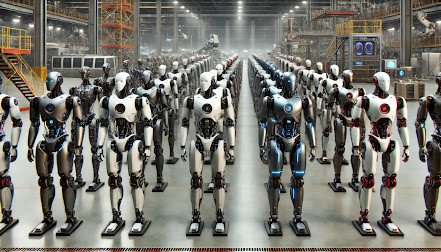(Forward: Many small investors cannot buy into Tesla directly nor any of the other "private" companies that are poised to charge into the robot industry. However, there is always a back door!)
The evolution of robots and robotics will rely heavily on a range of raw materials, each contributing to various aspects of robot construction, functionality, and performance. Here are some of the key raw materials expected to be significant:
Metals and Alloys:
- Steel: For structural components due to its strength and durability.
- Aluminum: Used for lightweight structures, reducing the overall weight of robots.
- Titanium: Valued for its high strength-to-weight ratio and corrosion resistance.
- Copper: Essential for electrical wiring and components.
Semiconductors:
- Silicon: Fundamental for electronic circuits, sensors, and microchips.
- Gallium Arsenide: Used in high-speed electronics and optoelectronic devices.
Rare Earth Elements:
- Neodymium: Critical for powerful permanent magnets used in electric motors and actuators.
- Dysprosium: Enhances the performance of neodymium magnets, especially at high temperatures.
Composites and Polymers:
- Carbon Fiber: Provides high strength and low weight for structural components.
- Kevlar: Used for its toughness and resistance to impact and abrasion.
- High-Performance Plastics: Such as PEEK (polyether ether ketone) and PTFE (polytetrafluoroethylene) for various mechanical and thermal applications.
Battery Materials:
- Lithium: Central to lithium-ion batteries, which power many portable robots.
- Cobalt, Nickel, and Manganese: Used in battery cathodes to improve energy density and stability.
Sensors and Actuators:
- Piezoelectric Materials: Such as quartz or PZT (lead zirconate titanate) for precise motion control.
- MEMS (Micro-Electro-Mechanical Systems): Often made from silicon and polymers for sensors and actuators.
Optical Materials:
- Glass and Polymers: For lenses, cameras, and other optical sensors.
- Silica: Used in fiber optics for communication and data transmission.
Conductive and Insulating Materials:
- Gold and Silver: For high-conductivity electrical connections.
- Ceramics: Used for insulation and high-temperature applications.
These materials collectively enable the development of more advanced, efficient, and capable robots, pushing the boundaries of what robots can do in various industries, from manufacturing and healthcare to exploration and service applications.
Now, imagine the amount of cars on the planet! Now quadruple that for the robot revolution!




No comments:
Post a Comment